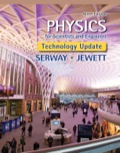
Concept explainers
In a certain region of space, the electric field is
(a)
The volume density of electric charge at
Answer
The volume density of electric charge at
Explanation of Solution
Given info: The electric field vector in the region of space is
Consider a Gaussian box of thickness
Formula to calculate the electric flux at
Here,
Write the expression for the electric field at
Substitute
Thus, electric field in the region of space at
The electric field enter into the box at
Substitute
Formula to calculate the electric flux at
Here,
Write the expression for the electric field at
The term
The electric field enter into the box at
Substitute
Write the expression for the net electric flux through the box.
Substitute
Write an alternate expression for the net electric flux from Gauss law.
Here,
Formula to calculate the volume of the Gaussian box is,
Here,
Formula to calculate the average charge enclosed inside the rectangular Gaussian surface is,
Here,
Replace
Substitute
Equate the equation (2) and (1) for same value of electric flux.
Substitute
Conclusion:
Therefore, the volume density of electric charge at
(b)
Whether the given region of space can be inside a conductor.
Answer
No, the given region of space could not be inside a conductor.
Explanation of Solution
Given info: The electric field vector in the region of space is
According to the principle of Electromagnetism, in electrostatics free charges in a good conductor reside only on the surface. So the free charge inside the conductor is zero. So the field in it is caused by charges on the surface. Since charges are of the same nature and distribution is uniform, the electric fields cancel each other. No matter, what is the shape of the conductor as long as there is field inside it, electrons always rearrange themselves to make the net field zero.
But, the volume density of electric charge at
Conclusion:
Therefore, the given region of space could not be inside a conductor.
Want to see more full solutions like this?
Chapter 24 Solutions
EBK PHYSICS FOR SCIENTISTS AND ENGINEER
- help me with the experimental set up for the excel i did. the grapharrow_forwardWhich of the following best describes how to calculate the average acceleration of any object? Average acceleration is always halfway between the initial acceleration of an object and its final acceleration. Average acceleration is always equal to the change in velocity of an object divided by the time interval. Average acceleration is always equal to the displacement of an object divided by the time interval. Average acceleration is always equal to the change in speed of an object divided by the time interval.arrow_forwardThe figure shows the velocity versus time graph for a car driving on a straight road. Which of the following best describes the acceleration of the car? v (m/s) t(s) The acceleration of the car is negative and decreasing. The acceleration of the car is constant. The acceleration of the car is positive and increasing. The acceleration of the car is positive and decreasing. The acceleration of the car is negative and increasing.arrow_forward
- Which figure could represent the velocity versus time graph of a motorcycle whose speed is increasing? v (m/s) v (m/s) t(s) t(s)arrow_forwardUnlike speed, velocity is a the statement? Poisition. Direction. Vector. Scalar. quantity. Which one of the following completesarrow_forwardNo chatgpt pls will upvote Already got wrong chatgpt answerarrow_forward
- 3.63 • Leaping the River II. A physics professor did daredevil stunts in his spare time. His last stunt was an attempt to jump across a river on a motorcycle (Fig. P3.63). The takeoff ramp was inclined at 53.0°, the river was 40.0 m wide, and the far bank was 15.0 m lower than the top of the ramp. The river itself was 100 m below the ramp. Ignore air resistance. (a) What should his speed have been at the top of the ramp to have just made it to the edge of the far bank? (b) If his speed was only half the value found in part (a), where did he land? Figure P3.63 53.0° 100 m 40.0 m→ 15.0 marrow_forwardPlease solve and answer the question correctly please. Thank you!!arrow_forwardYou throw a small rock straight up from the edge of a highway bridge that crosses a river. The rock passes you on its way down, 5.00 s after it was thrown. What is the speed of the rock just before it reaches the water 25.0 m below the point where the rock left your hand? Ignore air resistance.arrow_forward
- Help me make a visualize experimental setup using a word document. For the theory below.arrow_forwardHow to solve this, given answerarrow_forwardThree point-like charges are placed at the corners of a square as shown in the figure, 28.0 cm on each side. Find the minimum amount of work required by an external force to move the charge q1 to infinity. Let q1=-2.10 μC, q2=+2.40 μС, q3=+3.60 μC.arrow_forward
 Principles of Physics: A Calculus-Based TextPhysicsISBN:9781133104261Author:Raymond A. Serway, John W. JewettPublisher:Cengage Learning
Principles of Physics: A Calculus-Based TextPhysicsISBN:9781133104261Author:Raymond A. Serway, John W. JewettPublisher:Cengage Learning Physics for Scientists and Engineers: Foundations...PhysicsISBN:9781133939146Author:Katz, Debora M.Publisher:Cengage Learning
Physics for Scientists and Engineers: Foundations...PhysicsISBN:9781133939146Author:Katz, Debora M.Publisher:Cengage Learning Physics for Scientists and Engineers, Technology ...PhysicsISBN:9781305116399Author:Raymond A. Serway, John W. JewettPublisher:Cengage Learning
Physics for Scientists and Engineers, Technology ...PhysicsISBN:9781305116399Author:Raymond A. Serway, John W. JewettPublisher:Cengage Learning
 College PhysicsPhysicsISBN:9781305952300Author:Raymond A. Serway, Chris VuillePublisher:Cengage Learning
College PhysicsPhysicsISBN:9781305952300Author:Raymond A. Serway, Chris VuillePublisher:Cengage Learning College PhysicsPhysicsISBN:9781938168000Author:Paul Peter Urone, Roger HinrichsPublisher:OpenStax College
College PhysicsPhysicsISBN:9781938168000Author:Paul Peter Urone, Roger HinrichsPublisher:OpenStax College





